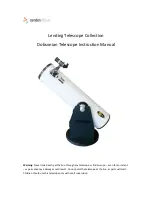
6
adjust the tilt of the secondary, changing the relative position of
the secondary center ring when peering through the collimation
eyepiece.
Secondary Mirror Adjustment
NOTE:
Only adjust the three screws around the perimeter
of the holder -- do not adjust the center screw!
(Figure 9)
.
Adjusting the center screw can cause the secondary mir-
ror to fall off and will not be covered under warranty.
A 4mm hex key is required to perform collimation on the sec-
ondary mirror
(Figure 9)
. When adjusting one of these screws
you will need to make counter-adjustments to the other two.
Therefore, if you are loosening one screw you will need to tight-
en the other two. At the end of the process you want all three
collimation screws to be reasonably tight so the secondary mir-
ror won’t shift while the scope is in use.
Always start by loosening one screw. Adjust the screws only
very slightly -- by no more than 1/10 turn at a time, and one
screw at a time before checking the view through the Cheshire
again to see how things changed. Only tiny adjustments should
be required to achieve collimation. This will also aid in the pre-
vention of accidently putting the telescope grossly out of colli-
mation. With each tiny tweak of a screw, make a mental note of
which way and how far the center dot moved, as that will inform
which screw to turn next and by how much. Experiment with
different combinations of loosening/tightening the three screws
Collimation
eyepiece
mark
Secondary mirror
center ring
Secondary
mirror holder
Reflective surface of
collimating eyepiece
Spider
vanes
Optical
axis
A
C
B
Figure 8.
The view through a Cheshire collimating eyepiece (not to scale). A) The optics in perfect alignment. B) The secondary mirror
slightly out of alignment. C) The optical axis out of alignment.
Figure 9.
The
secondary mirror
collimation
adjustment
screws. A 4mm
hex key is required.
Secondary
mirror
collimation
adjustment
screws
Do not
adjust center
screw!













